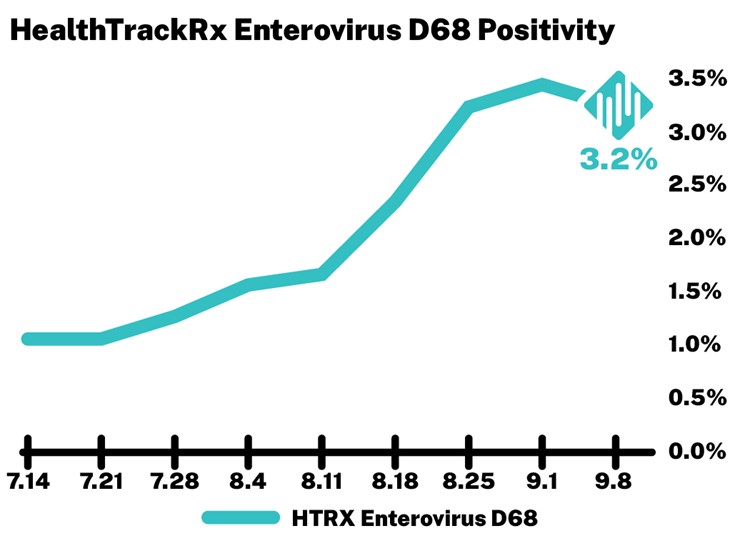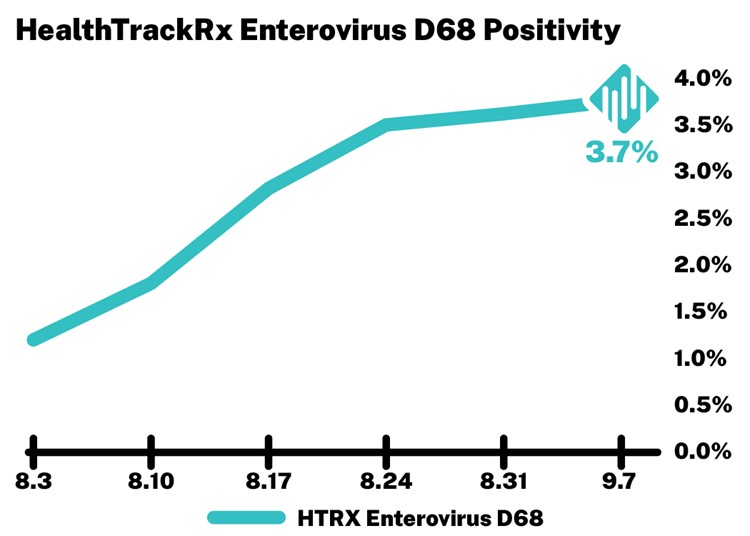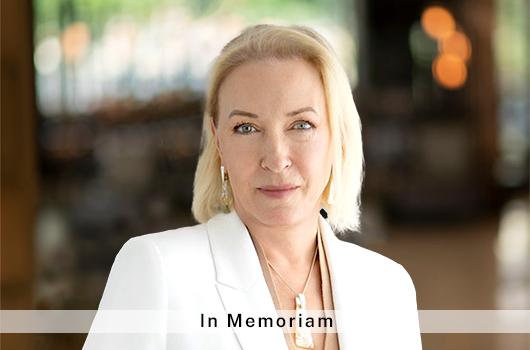Clinical Study
Shifting Epidemiology of Enterovirus D68: Unanticipated Odd-Year Spike in 2025

Dr. Pallavi Upadhyay • Sep 22, 2025
Introduction
Enterovirus D68 (ED68) is a single stranded RNA virus within the Picornaviridae family. It is a non-polio enterovirus which spreads via respiratory droplets thus causing respiratory illness.1 Clinical symptoms of the ED68 infections can range from mild cold-like symptoms to severe respiratory tract infections. Severe cases can require hospitalization or intensive care visit. EV-D68 is also associated with acute flaccid myelitis (AFM), which is an uncommon but serious neurological condition characterized by sudden limb weakness.2
Before pandemic, ED68 exhibited a late summer to early fall spikes, following a biennial, even-year circulation pattern with the United States. However, in 2020 and 2021, when the SARS-CoV-2 dominated the respiratory illness, drastically low levels of all respiratory viruses, including ED68 were noted in the population.3,4 This suppression of seasonal peaks levels was attributed to strict implementation of public health measures (including both pharmaceutical and non-pharmaceutical interventions, or NPIs) to curb the COVID-19 pandemic. However, once these restrictions were relaxed and later completely lifted, many respiratory viruses showed atypical and aseasonal resurgence. It was noted that both ED68 and rhinoviruses showed delayed or atypical late-summer spikes in 2022.4,5 These epidemiological shifts indicate towards waning of population immunity during the suppressed periods, and increased susceptibility during viral re-emergence. Scientists also suggest “immunity debt” phenomenon as the reason for atypical resurgences, which often result in an overwhelmed healthcare system and an enhanced clinical burden.6,7 In this study, we analyzed laboratory positivity data from August and September of 2023, 2024, and 2025, and report an unexpected spike in ED68 positivity in 2025, an odd year that diverges from the traditional biennial cycle. These findings highlight the importance of continuous surveillance and clinical vigilance for respiratory viruses outside expected seasonal patterns, especially in this post-pandemic landscape.
Study Findings: Positivity patterns in 2025
We performed a retrospective data analysis for the respiratory samples that were tested in the laboratory for enterovirus/rhinovirus during the months of August and September of 2023, 2024, and 2025 to evaluate seasonal circulation patterns of ED68.
Positivity trend analysis conducted for August through September of 2023, 2024, and 2025 demonstrate distinct circulation patterns across the three years. In 2023, ED68 activity was minimal, with only sporadic detections and no clear seasonal rise (data not shown). In contrast, 2024 demonstrated the expected seasonal increase, consistent with the historically observed late-summer spike (Fig.1), though overall positivity rates remained modest (Fig. 2) and started to plummet towards the end of September. Interestingly, the 2025 viral circulation patterns are showing an unexpected increase in ED68 positivity levels, with infection rates substantially higher than those recorded in the previous two years (2023-2024). While the 2025 increase occurred during the same late-summer-early fall months, the anomalous odd-year upsurge is atypical of the expected biennial ED68 spike (Fig. 3). Noteworthy, this pattern suggests a deviation from the expected biennial cycle of ED68, which has surpassed both the modest seasonal rise observed in 2024 and the baseline activity noted in 2023 (Manuscript in preparation).

Fig. 1: 2024 Mid July-Early Sep positivity trend of Enterovirus D68

Fig. 2: 2024 Mid Aug-Late Sep positivity trend of Enterovirus D68

Fig. 3: 2025 Early Aug-Early Sep positivity trend of Enterovirus D68
Conclusion: Possible interpretations and clinical implications
The recent global pandemic has underscored the impact of human behavior and public health measures on viral seasonality and circulation patterns. This recent unexpected, odd-year ED68 surge suggests an altered circulation pattern and accelerated susceptibility build-up in the populations. While the long-term impact of the COVID-19 pandemic on seasonality of other respiratory viruses has not been fully elucidated, continuous surveillance remains crucial for better clinical preparedness for respiratory illness months in the upcoming years, especially during atypical outbreaks. Our findings are important for not only the healthcare providers but also the wider community of caregivers, as early recognition of altered ED68 circulation patterns can directly impact patient management, supportive care decision-making, especially in vulnerable pediatric and elderly populations.
Future work
These findings represent preliminary data and an early snapshot of ED68 circulation pattern. A comprehensive analysis is currently in progress to compare ED68 activity in post-pandemic years, which will be presented in a forthcoming peer-reviewed publication later in 2025.
For more information on current respiratory trends and to sign up for bi-weekly reminders, please click here.
References
- Sinclair W, Omar M. Enterovirus. [Updated 2023 Jul 31]. In: StatPearls [Internet]. Treasure Island (FL): StatPearls Publishing; 2025 Jan. Available from: https://www.ncbi.nlm.nih.gov/books/NBK562330/. Accessed 9/12/2025
- CDC. About Enterovirus D68. https://www.cdc.gov/non-polio-enterovirus/about/about-enterovirus-d68.html. Accessed 9/12/2025
- CDC. Increase in acute respiratory illnesses among children and adolescents associated with rhinoviruses and enteroviruses, including Enterovirus D68 — United States, July–September 2022. https://www.cdc.gov/mmwr/volumes/71/wr/mm7140e1.htm. Accessed 9/12/2025
- Fall A, Han L, Abdullah O, Norton JM, Eldesouki RE, et al. An increase in enterovirus D68 circulation and viral evolution during a period of increased influenza like illness, The Johns Hopkins Health System, USA, 2022. J Clin Virol. 2023;160:105379.
- Ma KC, Winn A, Moline HL, New vaccine surveillance network collaborators, Hall AJ. Increase in acute respiratory illnesses among children and adolescents associated with rhinoviruses and enteroviruses, Including Enterovirus D68 – United States, July-September 2022. MMWR Morb Mortal Wkly Rep. 2022;71(40):1265-1270.
- Ghosal K, Adhikari A. Aerobiology of respiratory infectious viruses: recent paradoxes, mechanistic insights, and future perspectives. Aerobiology. 2025; 3(3):7.
- Messacar K, Baker RE, Park SW, Nguyen-Tran H, Cataldi JR, Grenfell B. Preparing for uncertainty: endemic paediatric viral illnesses after COVID-19 pandemic disruption. Lancet. 2022 Nov 12;400(10364):1663-1665. Erratum in: Lancet. 2022 Nov 12;400(10364):1680.
References
- Sinclair W, Omar M. Enterovirus. [Updated 2023 Jul 31]. In: StatPearls [Internet]. Treasure Island (FL): StatPearls Publishing; 2025 Jan. Available from: https://www.ncbi.nlm.nih.gov/books/NBK562330/. Accessed 9/12/2025
- CDC. About Enterovirus D68. https://www.cdc.gov/non-polio-enterovirus/about/about-enterovirus-d68.html. Accessed 9/12/2025
- CDC. Increase in acute respiratory illnesses among children and adolescents associated with rhinoviruses and enteroviruses, including Enterovirus D68 — United States, July–September 2022. https://www.cdc.gov/mmwr/volumes/71/wr/mm7140e1.htm. Accessed 9/12/2025
- Fall A, Han L, Abdullah O, Norton JM, Eldesouki RE, et al. An increase in enterovirus D68 circulation and viral evolution during a period of increased influenza like illness, The Johns Hopkins Health System, USA, 2022. J Clin Virol. 2023;160:105379.
- Ma KC, Winn A, Moline HL, New vaccine surveillance network collaborators, Hall AJ. Increase in acute respiratory illnesses among children and adolescents associated with rhinoviruses and enteroviruses, Including Enterovirus D68 – United States, July-September 2022. MMWR Morb Mortal Wkly Rep. 2022;71(40):1265-1270.
- Ghosal K, Adhikari A. Aerobiology of respiratory infectious viruses: recent paradoxes, mechanistic insights, and future perspectives. Aerobiology. 2025; 3(3):7.
- Messacar K, Baker RE, Park SW, Nguyen-Tran H, Cataldi JR, Grenfell B. Preparing for uncertainty: endemic paediatric viral illnesses after COVID-19 pandemic disruption. Lancet. 2022 Nov 12;400(10364):1663-1665. Erratum in: Lancet. 2022 Nov 12;400(10364):1680.
Related Articles and White papers

Dr. Pallavi Upadhyay • Sep 22, 2025
Introduction
Enterovirus D68 (ED68) is a single stranded RNA virus within the Picornaviridae family. It is a non-polio enterovirus which spreads via respiratory droplets thus causing respiratory illness.1 Clinical symptoms of the ED68 infections can range from mild cold-like symptoms to severe respiratory tract infections. Severe cases can require hospitalization or intensive care visit. EV-D68 is also associated with acute flaccid myelitis (AFM), which is an uncommon but serious neurological condition characterized by sudden limb weakness.2
Before pandemic, ED68 exhibited a late summer to early fall spikes, following a biennial, even-year circulation pattern with the United States. However, in 2020 and 2021, when the SARS-CoV-2 dominated the respiratory illness, drastically low levels of all respiratory viruses, including ED68 were noted in the population.3,4 This suppression of seasonal peaks levels was attributed to strict implementation of public health measures (including both pharmaceutical and non-pharmaceutical interventions, or NPIs) to curb the COVID-19 pandemic. However, once these restrictions were relaxed and later completely lifted, many respiratory viruses showed atypical and aseasonal resurgence. It was noted that both ED68 and rhinoviruses showed delayed or atypical late-summer spikes in 2022.4,5 These epidemiological shifts indicate towards waning of population immunity during the suppressed periods, and increased susceptibility during viral re-emergence. Scientists also suggest “immunity debt” phenomenon as the reason for atypical resurgences, which often result in an overwhelmed healthcare system and an enhanced clinical burden.6,7 In this study, we analyzed laboratory positivity data from August and September of 2023, 2024, and 2025, and report an unexpected spike in ED68 positivity in 2025, an odd year that diverges from the traditional biennial cycle. These findings highlight the importance of continuous surveillance and clinical vigilance for respiratory viruses outside expected seasonal patterns, especially in this post-pandemic landscape.
Study Findings: Positivity patterns in 2025
We performed a retrospective data analysis for the respiratory samples that were tested in the laboratory for enterovirus/rhinovirus during the months of August and September of 2023, 2024, and 2025 to evaluate seasonal circulation patterns of ED68.
Positivity trend analysis conducted for August through September of 2023, 2024, and 2025 demonstrate distinct circulation patterns across the three years. In 2023, ED68 activity was minimal, with only sporadic detections and no clear seasonal rise (data not shown). In contrast, 2024 demonstrated the expected seasonal increase, consistent with the historically observed late-summer spike (Fig.1), though overall positivity rates remained modest (Fig. 2) and started to plummet towards the end of September. Interestingly, the 2025 viral circulation patterns are showing an unexpected increase in ED68 positivity levels, with infection rates substantially higher than those recorded in the previous two years (2023-2024). While the 2025 increase occurred during the same late-summer-early fall months, the anomalous odd-year upsurge is atypical of the expected biennial ED68 spike (Fig. 3). Noteworthy, this pattern suggests a deviation from the expected biennial cycle of ED68, which has surpassed both the modest seasonal rise observed in 2024 and the baseline activity noted in 2023 (Manuscript in preparation).

Fig. 1: 2024 Mid July-Early Sep positivity trend of Enterovirus D68

Fig. 2: 2024 Mid Aug-Late Sep positivity trend of Enterovirus D68

Fig. 3: 2025 Early Aug-Early Sep positivity trend of Enterovirus D68
Conclusion: Possible interpretations and clinical implications
The recent global pandemic has underscored the impact of human behavior and public health measures on viral seasonality and circulation patterns. This recent unexpected, odd-year ED68 surge suggests an altered circulation pattern and accelerated susceptibility build-up in the populations. While the long-term impact of the COVID-19 pandemic on seasonality of other respiratory viruses has not been fully elucidated, continuous surveillance remains crucial for better clinical preparedness for respiratory illness months in the upcoming years, especially during atypical outbreaks. Our findings are important for not only the healthcare providers but also the wider community of caregivers, as early recognition of altered ED68 circulation patterns can directly impact patient management, supportive care decision-making, especially in vulnerable pediatric and elderly populations.
Future work
These findings represent preliminary data and an early snapshot of ED68 circulation pattern. A comprehensive analysis is currently in progress to compare ED68 activity in post-pandemic years, which will be presented in a forthcoming peer-reviewed publication later in 2025.
For more information on current respiratory trends and to sign up for bi-weekly reminders, please click here.
References
- Sinclair W, Omar M. Enterovirus. [Updated 2023 Jul 31]. In: StatPearls [Internet]. Treasure Island (FL): StatPearls Publishing; 2025 Jan. Available from: https://www.ncbi.nlm.nih.gov/books/NBK562330/. Accessed 9/12/2025
- CDC. About Enterovirus D68. https://www.cdc.gov/non-polio-enterovirus/about/about-enterovirus-d68.html. Accessed 9/12/2025
- CDC. Increase in acute respiratory illnesses among children and adolescents associated with rhinoviruses and enteroviruses, including Enterovirus D68 — United States, July–September 2022. https://www.cdc.gov/mmwr/volumes/71/wr/mm7140e1.htm. Accessed 9/12/2025
- Fall A, Han L, Abdullah O, Norton JM, Eldesouki RE, et al. An increase in enterovirus D68 circulation and viral evolution during a period of increased influenza like illness, The Johns Hopkins Health System, USA, 2022. J Clin Virol. 2023;160:105379.
- Ma KC, Winn A, Moline HL, New vaccine surveillance network collaborators, Hall AJ. Increase in acute respiratory illnesses among children and adolescents associated with rhinoviruses and enteroviruses, Including Enterovirus D68 – United States, July-September 2022. MMWR Morb Mortal Wkly Rep. 2022;71(40):1265-1270.
- Ghosal K, Adhikari A. Aerobiology of respiratory infectious viruses: recent paradoxes, mechanistic insights, and future perspectives. Aerobiology. 2025; 3(3):7.
- Messacar K, Baker RE, Park SW, Nguyen-Tran H, Cataldi JR, Grenfell B. Preparing for uncertainty: endemic paediatric viral illnesses after COVID-19 pandemic disruption. Lancet. 2022 Nov 12;400(10364):1663-1665. Erratum in: Lancet. 2022 Nov 12;400(10364):1680.
References
- Sinclair W, Omar M. Enterovirus. [Updated 2023 Jul 31]. In: StatPearls [Internet]. Treasure Island (FL): StatPearls Publishing; 2025 Jan. Available from: https://www.ncbi.nlm.nih.gov/books/NBK562330/. Accessed 9/12/2025
- CDC. About Enterovirus D68. https://www.cdc.gov/non-polio-enterovirus/about/about-enterovirus-d68.html. Accessed 9/12/2025
- CDC. Increase in acute respiratory illnesses among children and adolescents associated with rhinoviruses and enteroviruses, including Enterovirus D68 — United States, July–September 2022. https://www.cdc.gov/mmwr/volumes/71/wr/mm7140e1.htm. Accessed 9/12/2025
- Fall A, Han L, Abdullah O, Norton JM, Eldesouki RE, et al. An increase in enterovirus D68 circulation and viral evolution during a period of increased influenza like illness, The Johns Hopkins Health System, USA, 2022. J Clin Virol. 2023;160:105379.
- Ma KC, Winn A, Moline HL, New vaccine surveillance network collaborators, Hall AJ. Increase in acute respiratory illnesses among children and adolescents associated with rhinoviruses and enteroviruses, Including Enterovirus D68 – United States, July-September 2022. MMWR Morb Mortal Wkly Rep. 2022;71(40):1265-1270.
- Ghosal K, Adhikari A. Aerobiology of respiratory infectious viruses: recent paradoxes, mechanistic insights, and future perspectives. Aerobiology. 2025; 3(3):7.
- Messacar K, Baker RE, Park SW, Nguyen-Tran H, Cataldi JR, Grenfell B. Preparing for uncertainty: endemic paediatric viral illnesses after COVID-19 pandemic disruption. Lancet. 2022 Nov 12;400(10364):1663-1665. Erratum in: Lancet. 2022 Nov 12;400(10364):1680.





